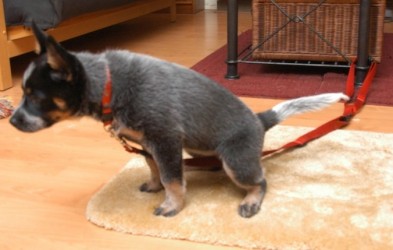
You will want to be able to take your puppy for walks and for rides. You need to get him used to meeting people and other animals. There are many ways to acclimate him to the new surroundings. You must take your time and not push the pup into a situation where he is uncomfortable. Puppies don’t come into the world knowing all the right things to do, so be patient and have fun with him.
The first few months of the puppy’s life is the best time to introduce him to all the wonders in the world. Expose the pups to everyday chores in the household. The mother will also teach them some social skills.
As soon as you bring the new pup home, introduce him to the family in a quiet setting. This gives him time to get to know the person without the noise of many people in the background. That can cause undue stress on the new puppy.
As soon as the puppy is vaccinated and the vet says it is alright, start taking the puppy on walks and outings so he can begin to get used to his surroundings.
Make sure your puppy meets people of every age. He might become frightened later if you only introduce him to elderly people and he runs into some children. This can also lead to aggressive behaviours in some dogs. Give the person you are introducing a small treat to give to the puppy. This will help build trust between the two. They can even get down on the dog’s level and play on the floor with him after a couple of meetings.
Please remember that socializing your puppy is not “only” letting them play with other dogs. That would simply be too easy. Puppy socialization is the exposure to the activities of daily life with their new family (pack). The training of your puppy begins the moment you bring them to your home and not at 6 months of age when they have already learned some unwanted (destructive) behaviours. As such, basic obedience training is a perfect form of socializing your puppy with other people and dogs. It will also teach them proper pack structure, as well as expected behaviours around social interaction.
If you don’t have time to invest in the adventure of raising a puppy, please don’t bring one home. They do need lots of patience and caring their first months with you. They need to follow a schedule to learn what is expected and before you know it, they will become a wonderful member of your family and be a special part of your life for many years to come.
—–
Written by: Andy Krzus

People often say “I’ve done everything I could to teach my puppy bathroom etiquette and yet he/she still makes accidents. What else can I do to help my dog succeed without further frustrations?” I have received numerous requests to assist my clients with this daunting task.
Where do we start then, assuming that every dog is at a completely different developmental stage? I try to explain to my clients that, no matter how much training they have done up to this point, we will either start from scratch or build and reinforce the foundation training that they have already started.
Puppies are definitely easier to train than older dogs as they haven’t had a chance to learn bad habits. Also, we can treat puppies with the approach of a “blank slate ” reinforcing the newly learned behaviour. This is how I go about it.
A few things to cover before we start the actual training:
-
Communication
- Please remember that you are trying to teach your dog a new skill in opposed to making them afraid of you. Soft and gentle assurance goes way further than screaming at your dog and yanking them around. So when you find yourself getting frustrated and ready to snap, simply put your dog away and take break.
- Puppies need to go to the bathroom quite often; I would put them on a fairly strict schedule, more or less every 2 – 3 hours. What does it entail? When you wake up in the morning, you take them from their crate/enclosure straight to the bathroom, before letting them engage with you and make an accident. Remember it only takes them a split second to squat and make a pee.
- Other important times that I would encourage you to take your puppy out is right before you stop playing with them, as it probably is the most common reason for accidents inside your house. You might also want to take them out 5 – 15 minutes after feeding. I hope this one is self explanatory.
- What to do about occasional accidents? As much as possible ignore them, pick your puppy up and take them outside, showing them where to go. Please don’t rub their face in their own urine or poop, it doesn’t work.
- What name will you attach to this new behavior? Various commands can be used. Here are some that I’ve heard so far:
- Go pee
- Go poo
- Go potty
- Hurry up
- Go outside, etc.
- I will allow myself to presume here, that most people will have some sort of a crate (soft or plastic one) for their puppy/grown dog. I will explain the reason for having a crate in step number three.
Once you make your choice remember only this. Consistency on your part will bring tremendous results!
2. Where is your dog’s designated bathroom place?
- My dogs go to bathroom on command and they always go to the same spot. I made a 6×6 sandbox, which I then filled with small rocks. It’s easier to clean and sanitize the area. I know some people will fill the box with sand, fresh wood chips etc. Gravel works for me. Depending on your living conditions you will need to find a place that you will be able to use on a consistent basis.
3. Business time ‘Go potty’
- First we teach our dogs to go potty while on leash, so they learn that it isn’t up to them when and where they go. We have to step into the designated area with them and softly encourage them by using our “pre-planned command”. How long will it take the first time? Sometimes it doesn’t happen at all, that’s right NOTHING AT ALL! By then you are ready to simply quit. DON’T!
- Assuming your dog refuses to go to the bathroom when you ask them to, you might need to stick around for a while and give them enough time to get at ease in the new area. If that doesn’t work, you simply take your dog (including picking them up if needed) and put them right back in their crate. Dogs are den animals and most of them do not like going to the bathroom where they sleep.
- 15 minutes later we will repeat the first step over again. If you are strapped for time, you might just need to take them elsewhere, so you can proceed on your way. However, when you return home, you will need to go back to your regular schedule enforcement.
- One of my dogs, Nika, was quite opposed to the idea of going to bathroom on gravel and refused to do so for three continuous days. I would still take her to her designated area prior to allowing her to go elsewhere. Although it would not be allowed in my backyard, not to give her any ideas that it was OK to do it between ‘cedar trees’ for example.
- It was extremely frustrating at times. I think I stood with her on the gravel once for 45 minutes in the rain. That was Nika’s breaking point though. When she finally decided to go to the bathroom that day, I made a huge deal (mini celebration) out of it, to ensure she understood what it was all about.
- The next week I continued to take her out on leash to ensure consistency and also, to instil in her mind, that it was the only place that she was allowed to use as a bathroom in my backyard. In total, it took us two and a half weeks of going outside together, before I tested if she was ready to go on her own.
Needless to say, it was a great feeling of accomplishment on my part, taking into consideration the fact that it rained for two weeks out of two and a half, while I was teaching Nika this skill. Now I can simply open the back door and ask my dogs to “go potty”. Perseverance plays a a very important role in this entire process. Some dogs learn faster than others. One thing that they all learn fairly quickly is that we occasionally lack consistency and patience, which they often use to our detriment.
Yet again, I would not put a time frame on this process as the learning proccess is quite different for every dog out there. Also, I have tested this process with both, puppies and fully grown dogs and it works! My dogs learned this skill in the span of 2 – 3 weeks of consistent practice and so can yours. Brace yourself with patience and please let me know if it worked for you too.


